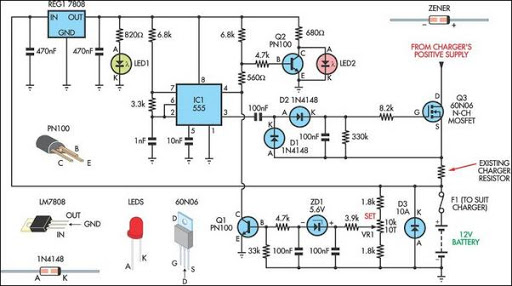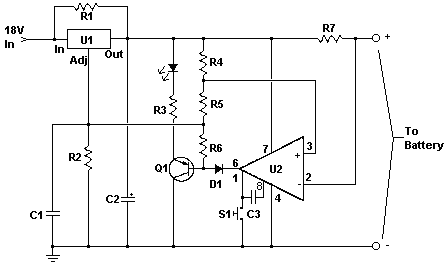
200Ma-12v ni-cad battery charger

This circuit charges a battery at a rate of 75 mA, allowing the battery to remain in the charger indefinitely until fully charged. Once the battery reaches its full charge, the circuit reduces the current to a trickle rate. To set the shut-off point, a 270-ohm, 2-watt resistor should be connected across the charge terminals. This configuration enables the complete recharge of a dead battery within four hours, and a potentiometer can be adjusted to achieve 15 volts across the resistor.
The described circuit is a battery charger designed to provide a constant charging current of 75 mA, suitable for maintaining and recharging batteries efficiently. The circuit allows for indefinite connection to the battery, ensuring that the battery is charged without the risk of overcharging. When the battery reaches full charge, the circuit automatically transitions to a trickle charge mode, which helps to maintain the battery's charge without causing damage.
To implement the shut-off point effectively, a 270-ohm, 2-watt resistor is strategically placed across the charge terminals. This resistor plays a critical role in regulating the current flow and preventing overcharging. The use of a potentiometer in the circuit allows for fine-tuning of the voltage across the resistor, with an optimal setting of 15 volts. This adjustment ensures that the charging current remains stable and within safe limits for the battery being charged.
The circuit's design facilitates the complete recharging of a dead battery within approximately four hours, making it a practical solution for users needing a reliable battery charging system. The combination of a fixed charging current, adjustable voltage, and automatic transition to trickle charging enhances the overall efficiency and safety of the charging process. Proper selection of components and careful tuning of the potentiometer are essential to achieving the desired performance and longevity of the battery.This circuit charges the battery at 75 mA battery can be left in the charger indefinitely, until the battery is charged, then it reduces the To set the shut-off point, connect a 270-ohm, current to a trickle rate It will completely 2-watt resistor across the charge terminals and recharge a dead battery in four hours and the adjust the pot for 15 volts across the resistor.
The described circuit is a battery charger designed to provide a constant charging current of 75 mA, suitable for maintaining and recharging batteries efficiently. The circuit allows for indefinite connection to the battery, ensuring that the battery is charged without the risk of overcharging. When the battery reaches full charge, the circuit automatically transitions to a trickle charge mode, which helps to maintain the battery's charge without causing damage.
To implement the shut-off point effectively, a 270-ohm, 2-watt resistor is strategically placed across the charge terminals. This resistor plays a critical role in regulating the current flow and preventing overcharging. The use of a potentiometer in the circuit allows for fine-tuning of the voltage across the resistor, with an optimal setting of 15 volts. This adjustment ensures that the charging current remains stable and within safe limits for the battery being charged.
The circuit's design facilitates the complete recharging of a dead battery within approximately four hours, making it a practical solution for users needing a reliable battery charging system. The combination of a fixed charging current, adjustable voltage, and automatic transition to trickle charging enhances the overall efficiency and safety of the charging process. Proper selection of components and careful tuning of the potentiometer are essential to achieving the desired performance and longevity of the battery.This circuit charges the battery at 75 mA battery can be left in the charger indefinitely, until the battery is charged, then it reduces the To set the shut-off point, connect a 270-ohm, current to a trickle rate It will completely 2-watt resistor across the charge terminals and recharge a dead battery in four hours and the adjust the pot for 15 volts across the resistor.





